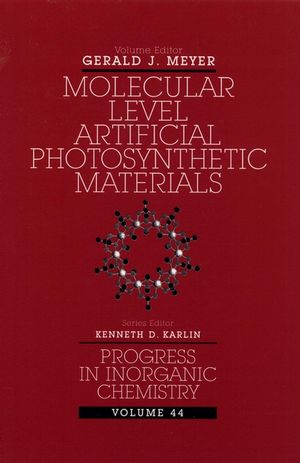Molecular Level Artificial Photosynthetic Materials, Volume 44ISBN: 978-0-471-12535-8
Hardcover
421 pages
October 1996
 This is a Print-on-Demand title. It will be printed specifically to fill your order. Please allow an additional 10-15 days delivery time. The book is not returnable.
|
||||||
Discover the exciting, promising field of molecular level artificial photosynthesis
This special volume of Progress in Inorganic Chemistry presents the theory and practice of molecular artificial photosynthesis-a field holding tremendous promise now that molecular solar energy materials are fast becoming competitive with their solid-state counterparts.
The only book on the market to address this important area of inorganic research, Molecular Level Artificial Photosynthetic Materials shows us, in effect, how to imitate the complex natural processes of photosynthesis-featuring state-of-the-art strategies and techniques for creating artificial photosynthetic devices at the molecular level. It takes a multidisciplinary approach, drawing on materials science techniques used in the design of solar energy devices, examining the molecular nature of the chemistry involved, and applying existing knowledge in inorganic photochemistry and photophysics to the growing pool of molecular photonic materials.
Composed of seven superbly crafted contributions by leading experts in the field, this comprehensive work
* Describes molecular components integrated within nanophase materials, gels, zeolites, thin films, and layered solids
* Uses novel time resolved vibrational spectroscopies to elucidate fundamental electron and energy transfer mechanisms in complex supramolecular compounds
* Highlights practical applications such as the conversion of light into electricity, solar detoxification of pollutants, and the production of useful fuels-including the splitting of water into hydrogen and oxygen
* Points to areas of future research and usefulness for inorganic photochemists, as well as for students, chemists, material scientists, physicists, and engineers in a wide range of fields
This special volume of Progress in Inorganic Chemistry presents the theory and practice of molecular artificial photosynthesis-a field holding tremendous promise now that molecular solar energy materials are fast becoming competitive with their solid-state counterparts.
The only book on the market to address this important area of inorganic research, Molecular Level Artificial Photosynthetic Materials shows us, in effect, how to imitate the complex natural processes of photosynthesis-featuring state-of-the-art strategies and techniques for creating artificial photosynthetic devices at the molecular level. It takes a multidisciplinary approach, drawing on materials science techniques used in the design of solar energy devices, examining the molecular nature of the chemistry involved, and applying existing knowledge in inorganic photochemistry and photophysics to the growing pool of molecular photonic materials.
Composed of seven superbly crafted contributions by leading experts in the field, this comprehensive work
* Describes molecular components integrated within nanophase materials, gels, zeolites, thin films, and layered solids
* Uses novel time resolved vibrational spectroscopies to elucidate fundamental electron and energy transfer mechanisms in complex supramolecular compounds
* Highlights practical applications such as the conversion of light into electricity, solar detoxification of pollutants, and the production of useful fuels-including the splitting of water into hydrogen and oxygen
* Points to areas of future research and usefulness for inorganic photochemists, as well as for students, chemists, material scientists, physicists, and engineers in a wide range of fields



